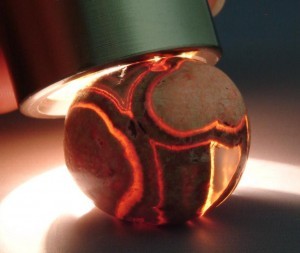#thermoluminescence
Types of Luminescence
Despite the numberof typesof luminescencealready covered, there are still several more to talk about.
Electroluminescence is when light is emitted due to the passage of an electric current or a strong electric field and is usually seen in semiconductors (such as LEDs). Electroluminescent technologies use relatively low power, though at high voltage, and can be quite thin. This form of luminescence is responsible for the two central images shown above, as well as the Indiglo feature available in many watches.
Similar to electroluminescence, cathodoluminescence is a form of luminescence in which electrons impact a luminescent material and cause the emission of photons which may have wavelengths in the visible spectrum and is mainly seen in semiconductors. One well known example is in cathode ray tubes in televisions. Optical cathodoluminescence microscopes can be used similarly to scanning electron microscopes to examine internal structures of materials.
Radioluminescence occurs by bombardment of materials with ionizing radiation such as beta particles. It is used in applications where light must be produced for long periods without external energy sources. The upper left hand images are illuminated using radioluminescence.
Thermoluminescence is a form of luminescence that is exhibited by certain crystalline materials when previously absorbed energy is re-emitted as light upon heating of the material. It is not the same as black body radiation, when a material glows due to heating. It’s main application is in dating buried objects that have been heated in the past, such as pottery. The upper right image and bottom image illustrate thermoluminescence.
Finally, crystalloluminescence is luminescence produced during crystallization, but it has not been widely studied and not much is known about it.
Sources:Electroluminescence,Cathodoluminescence,Radioluminescence,Thermoluminescence,Crystalloluminescence
Post link
The above video, from YouTuber Julien Simon shows the thermoluminescent properties of fluorite crystals.





